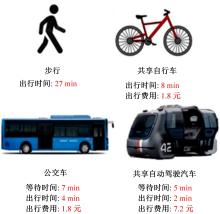吉林大学学报(工学版) ›› 2023, Vol. 53 ›› Issue (12): 3424-3431.doi: 10.13229/j.cnki.jdxbgxb.20220912
• 交通运输工程·土木工程 • 上一篇
共享无人驾驶汽车对地铁站接驳方式选择的影响
- 1.武汉轻工大学 土木工程与建筑学院,武汉 430023
2.华南理工大学 土木与交通学院,广州 510640
Impact of shared autonomous vehicles on choice of subway station connection methods
Zhi-wei LIU1( ),Zheng-yun SONG1,Jian-rong LIU2(
),Zheng-yun SONG1,Jian-rong LIU2( )
)
- 1.School of Civil Engineering and Architecture,Wuhan Polytechnic University,Wuhan 430023,China
2.School of Civil Engineering and Transportation,South China University of Technology,Guangzhou 510640,China
摘要:
为了研究出行者选择偏好异质性和共享无人驾驶汽车解决地铁出行最后一公里接驳问题的潜力,基于计划行为理论,对出行者最后一公里的出行方式选择进行了分析。首先,建立了潜变量模型,获取出行者对无人驾驶汽车的态度、主观规范、感知行为控制和行为意向等心理潜变量;其次,将心理潜变量纳入随机系数Logit模型,进行实证分析研究了地铁出行“最后一公里”出行行为的影响因素;最后,进行弹性分析,研究了出行时间对出行方式选择的影响程度。研究结果表明:随机系数Logit模型比传统的多项Logit模型拟合度更优;不同出行者对出行时间的偏好具有异质性,出行时间系数不是一个固定值,而是服从均值为-0.153、标准差为0.520的正态分布;出行者对无人驾驶汽车的态度和感知的主观规范对出行行为具有显著影响;共享无人驾驶汽车的出行时间每减少1%,共享无人驾驶汽车的选择概率上升0.799%;而共享自行车的出行时间每增加1%,选择共享无人驾驶汽车的选择概率上升1.155%。
中图分类号:
- U121
| 1 | Mokhtarian P L. The times they are a-changing? what do the expanding uses of travel time portend for policy, planning, and life?[J]. Transportation Research Record, 2018, 2672(47): 1-11. |
| 2 | 景鹏,隽志才,查奇芬. 考虑心理潜变量的出行方式选择行为模型[J]. 中国公路学报, 2014, 27(11): 84-92. |
| Jing Peng, Zhi-cai Juan, Zha Qi-fen. Incorporating psychological latent variables into travel mode choice model[J]. China Journal of Highway and Transport, 2014, 27(11): 84-92. | |
| 3 | 鞠鹏, 周晶, 徐红利, 等. 基于混合选择模型的汽车共享选择行为研究[J]. 交通运输系统工程与信息, 2016, 17(2): 7-13. |
| Ju Peng, Zhou Jing, Xu Hong-li, et al. Travelers' choice behavior of car sharing based on hybrid choice model[J]. Journal of Transportation Systems Engineering & Information Technology, 2017, 17(2): 7-13. | |
| 4 | 刘志伟,刘建荣,邓卫. 基于潜在类别的无人驾驶汽车选择行为[J]. 吉林大学学报: 工学版, 2021, 51(4): 1261-1268. |
| Liu Zhi-wei, Liu Jian-rong, Deng Wei. Impact of autonomous vehicle on travel mode choice behavior[J]. Journal of Jilin University(Engineering and Technology Edition), 2021, 51(4): 1261-1268. | |
| 5 | 姚荣涵, 梁亚林, 刘锴, 等. 考虑合乘的共享自动驾驶汽车选择行为实证分析[J]. 交通运输系统工程与信息, 2020, 20(1): 228-233. |
| Yao Rong-han, Liang Ya-lin, Liu Kai, et al. An empirical analysis on the choice behavior of shared autonomous vehicle considering ride-sharing[J]. Transportation Systems Engineering and Information, 2020, 20(1): 228-233. | |
| 6 | Zhao R, Yang L, Liang X, et al. Last-mile travel mode choice: data-mining hybrid with multiple attribute decision making[J]. Sustainability, 2019, 11(23): No. 6733. |
| 7 | Moorthy A, de Kleine R, Keoleian G, et al. Shared autonomous vehicles as a sustainable solution to the last mile problem: a case study of ANN Arbor-Detroit area[J]. SAE International Journal of Passenger Cars-Electronic and Electrical Systems, 2017, 10(1): 328-336. |
| 8 | Yap M D, Correia G, van Arem B. Preferences of travellers for using automated vehicles as last mile public transport of multimodal train trips[J]. Transportation Research Part A: Policy and Practice, 2016, 94(12): 1-16. |
| 9 | Adnan M, Altaf S, Bellemans T, et al. Last-mile travel and bicycle sharing system in small/medium sized cities: user's preferences investigation using hybrid choice model[J]. Journal of Ambient Intelligence and Humanized Computing, 2019, 10(12): 4721-4731. |
| 10 | Baek K, Lee H, Chung J H, et al. Electric scooter sharing: How do people value it as a last-mile transportation mode?[J]. Transportation Research Part D: Transport and Environment, 2021, 90: No. 102642. |
| 11 | Yap M D, Correia G, van Arem B. Valuation of travel attributes for using automated vehicles as egress transport of multimodal train trips[J]. Transportation Research Procedia, 2015: 10: 462-471. |
| 12 | Moorthy A, de Kleine R, Keoleian G, et al. Shared autonomous vehicles as a sustainable solution to the last mile problem: a case study of ANN Arbor-Detroit area[J]. SAE International Journal of Passenger Cars-Electronic and Electrical Systems, 2017, 10(1): 328-336. |
| 13 | 王灿, 王德, 朱玮, 等. 离散选择模型研究进展[J]. 地理科学进展, 2015, 34(10): 1275-1287. |
| Wang Can, Wang De, Zhu Wei, et al. Research progress of discrete choice models[J]. Progress in Geography, 2015, 34(10): 1275-1287. | |
| 14 | Liu Z, Deng W, Chen Y. Influence of autonomous vehicles on short and medium distance mode choice for intercity travel[C]∥SAE Technical Paper, 2020-01-5200. |
| 15 | Bhat C R. Simulation estimation of mixed discrete choice models using randomized and scrambled Halton sequences[J]. Transportation Research Part B: Methodological, 2003, 37(9): 837-855. |
| 16 | Jmp A, Proust M. Design of Experiments Guide[M]. Cary, NC: SAS Institute Inc, 2010. |
| 17 | Wang J, Wang X. Structural Equation Modeling: Applications using Mplus[M]. New York: John Wiley & Sons, 2019. |
| 18 | Zhou H, Norman R, Xia J C, et al. Analysing travel mode and airline choice using latent class modelling: a case study in western Australia[J]. Transportation Research Part A: Policy and Practice, 2020, 137(7): 187-205. |
| 19 | Olfindo R, Transport accessibility, residential satisfaction, and moving intention in a context of limited travel mode choice[J]. Transportation Research Part A: Policy and Practice, 2021, 145(3): 153-166. |
| 20 | Haboucha C J, Ishaq R, Shiftan Y. User preferences regarding autonomous vehicles[J]. Transportation Research Part C: Emerging Technologies, 2017, 78(5): 37-49. |
| 21 | Yuen K F, Huyen D T K, Wang X, et al. Factors influencing the adoption of shared autonomous vehicles[J]. International Journal of Environmental Research and Public Health, 2020, 17(13): No. 4868. |
| 22 | Aziz H A, Ukkusuri S V, Hasan S. Exploring the determinants of pedestrian-vehicle crash severity in New York city[J]. Accident Analysis & Prevention, 2013, 50(1): 1298-1309. |
| [1] | 张健,李青扬,李丹,姜夏,雷艳红,季亚平. 基于深度强化学习的自动驾驶车辆专用道汇入引导[J]. 吉林大学学报(工学版), 2023, 53(9): 2508-2518. |
| [2] | 郑植,袁佩,金轩慧,魏思斯,耿波. 桥墩复合材料柔性防撞护舷试验[J]. 吉林大学学报(工学版), 2023, 53(9): 2581-2590. |
| [3] | 李建华,王泽鼎. 考虑路径耗时的城市汽车分布式充电桩选点规划[J]. 吉林大学学报(工学版), 2023, 53(8): 2298-2303. |
| [4] | 李洪涛,王琳虹,李俊达. 公路交叉口照明和限速对视觉搜索能力的影响[J]. 吉林大学学报(工学版), 2023, 53(8): 2287-2297. |
| [5] | 田国红,代鹏杰. 基于单亲遗传算法的无人驾驶汽车主动避撞方法[J]. 吉林大学学报(工学版), 2023, 53(8): 2404-2409. |
| [6] | 巫威眺,曾坤,周伟,李鹏,靳文舟. 基于多源数据和响应面优化的公交客流预测深度学习方法[J]. 吉林大学学报(工学版), 2023, 53(7): 2001-2015. |
| [7] | 程国柱,盛林,赵浩,冯天军. 基于危险度分析的信号交叉口专用相位设置条件[J]. 吉林大学学报(工学版), 2023, 53(7): 1962-1969. |
| [8] | 何永明,陈世升,冯佳,万亚楠. 基于高精地图的超高速公路虚拟轨道系统[J]. 吉林大学学报(工学版), 2023, 53(7): 2016-2028. |
| [9] | 薛志佳,王召阳,张久鹏,晏长根,许子凯,张英立,黄晓明,马涛. 泥石流作用下道路结构韧性分析及提升[J]. 吉林大学学报(工学版), 2023, 53(6): 1773-1781. |
| [10] | 刘振亮,赵存宝,吴云鹏,马迷娜,马龙双. 数据驱动的公路桥梁网络全寿命抗震韧性评估[J]. 吉林大学学报(工学版), 2023, 53(6): 1695-1701. |
| [11] | 贾洪飞,徐英俊,杨丽丽,王楠. 商品车多式联运联盟成员选择及利益分配[J]. 吉林大学学报(工学版), 2023, 53(4): 1060-1069. |
| [12] | 孙超,尹浩为,汤文蕴,褚昭明. 交通需求估计下的检测器布局和手机数据扩样推断[J]. 吉林大学学报(工学版), 2023, 53(4): 1070-1077. |
| [13] | 常玉林,徐文倩,孙超,张鹏. 车联网环境下考虑遵从程度的混合流量逐日均衡[J]. 吉林大学学报(工学版), 2023, 53(4): 1085-1093. |
| [14] | 姚荣涵,徐文韬,郭伟伟. 基于因子长短期记忆的驾驶人接管行为及意图识别[J]. 吉林大学学报(工学版), 2023, 53(3): 758-771. |
| [15] | 肖雪,李克平,彭博,昌满玮. 基于决策-规划迭代框架的智驾车换道行为建模[J]. 吉林大学学报(工学版), 2023, 53(3): 746-757. |
|
||

